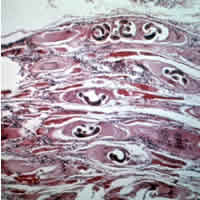Difference between revisions of "Trichinella"
| (4 intermediate revisions by the same user not shown) | |||
| Line 1: | Line 1: | ||
| + | {{OpenPagesTop}} | ||
| + | {{Podcasts | ||
| + | |link = http://media.bloomsburymediacloud.org/podcasts/wikivet-english/trichinella | ||
| + | }} | ||
==Introduction== | ==Introduction== | ||
[[File:Trichinella larvaeD.jpg|thumb|200px|right|''Trichinella'' in tissues. Sourced from Wikimedia commons.]] | [[File:Trichinella larvaeD.jpg|thumb|200px|right|''Trichinella'' in tissues. Sourced from Wikimedia commons.]] | ||
| Line 51: | Line 55: | ||
<br><br> | <br><br> | ||
| − | + | {{Mandy Nevel | |
| + | |date = 09 September 2011 | ||
| + | }} | ||
| + | |||
| + | {{OpenPages}} | ||
[[Category:Trichinelloidea]] | [[Category:Trichinelloidea]] | ||
[[Category:Intestinal Diseases - Pig]][[Category:Musculoskeletal Diseases - Pig]][[Category:Cardiovascular Diseases - Pig]] | [[Category:Intestinal Diseases - Pig]][[Category:Musculoskeletal Diseases - Pig]][[Category:Cardiovascular Diseases - Pig]] | ||
| − | [[Category:Pig_Nematodes]][[Category:Zoonoses]][[Category:CABI Expert Review]] | + | [[Category:Pig_Nematodes]][[Category:Zoonoses]][[Category:CABI Expert Review Completed]][[Category:CABI AHPC Pages]] |
| − | [[Category: | + | [[Category:Cardiology Section]] |
Latest revision as of 17:34, 17 October 2013
|
Introduction
Trichinella spiralis is a helminth parasite of the Trichinelloidea superfamily. It is unique among helminths as it is intracellular and requires only one host.
Disease is most important in pigs and wild boar due to its zoonotic transmission through eating pork. Trichinellosis is a serious public health hazard.
The trichinae are widespread across all continents. T. spiralis is found in temperate Europe, Asia, New Zealand, North and South America.
This disease is notifiable to the World Organisation for Animal Health (OIE)
Lifecycle
The lifecycle of T. spiralis is direct. Larvae are ingested by the pig through scavenging or predation. Free range outdoor pigs are therefore at highest risk. Gastric digestion releases the larvae from the infected muscle tissue. They then undergo moults and copulate in the small intestine after which the males die and the females penetrate into the intestinal mucosa.
The females then produce more larvae which can disseminate through the host in the blood and lymphatics, localising in the striated muscles. In pigs and wild boars, preferential sites appear to be the diaphragm, masseters and tongue. The muscle cells are transformed by the larvae within them, to form nurse cells which can supply nutrition and protects the larvae in a collagen capsule. Larvae can then survive in frozen and decaying carcasses forming an important route of transmission.
Humans are infected by eating raw or undercooked meat containing the infective larvae.
Pathogenesis
Damage is caused by penetrating female larvae in the small intestine and dissemination of larvae into the muscle masses. The degree of damage is dependent upon pathogen load.
Diagnosis
Direct microscopy of muscle samples between two glass plates can detect the organism.
Digestion with pepsin-HCl or ELISA testing is also possible.
Diseases
Trichinellosis is usually subclinical in pigs, forming muscular cysts.
Large burdens may cause enteritis followed by myositis, fever and myocarditis which can be fatal.
Human disease is serious and sometimes fatal, causing myositis, myocarditis, encephalitis and facial oedema.
Control
Anthelmintics can be used both as a treatment and control method for trichinellosis. Prevention of scavenging and feeding appropriate feedstuffs to pigs forms a major part in controlling the disease as well as meat inspection and destruction wherever trichinellosis is found.
Sampling of the diaphragm in the abattoir is performed routinely in most countries.
| Trichinella Learning Resources | |
|---|---|
 Test your knowledge using flashcard type questions |
Trichinella Flashcards |
References

|
This article was originally sourced from The Animal Health & Production Compendium (AHPC) published online by CABI during the OVAL Project. The datasheet was accessed on 8 June 2011. |
| This article has been expert reviewed by Dr Mandy Nevel Date reviewed: 09 September 2011 |
Error in widget FBRecommend: unable to write file /var/www/wikivet.net/extensions/Widgets/compiled_templates/wrt6933c85ba089b8_46640971 Error in widget google+: unable to write file /var/www/wikivet.net/extensions/Widgets/compiled_templates/wrt6933c85bb095e9_29628210 Error in widget TwitterTweet: unable to write file /var/www/wikivet.net/extensions/Widgets/compiled_templates/wrt6933c85bb910f9_78060483
|
| WikiVet® Introduction - Help WikiVet - Report a Problem |

